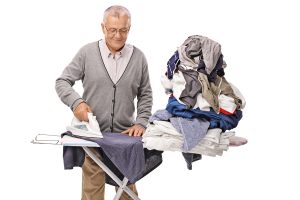 Non-exercise activity are all the things we take for granted but don’t count as real physical fitness exercise. All forms of movement contribute toward good health. The most underrated of them are everyday activities like housework, gardening and walking. More than we might think, daily activities count toward senior health and fitness and even prolong lives.
Non-exercise activity are all the things we take for granted but don’t count as real physical fitness exercise. All forms of movement contribute toward good health. The most underrated of them are everyday activities like housework, gardening and walking. More than we might think, daily activities count toward senior health and fitness and even prolong lives.
Some of these activities you’re already doing. Some of us go up and down stairs, do housework, fix and repair things, even taking a shower requires physical movement, stretching and some muscle exertion.
When you look at all the different exercises and workouts, there are five broad categories of activity. The five kinds of activities are:
- Non-exercise physical activity
- Aerobic exercise
- High intensity interval training
- Resistance training
- Recovery
NEAT: Non-Exercise Activity Thermogenesis
Don’t let anyone tell you that it takes a gym membership to qualify as physically active and fit. Just look at the muscles on a furniture mover, a massage therapist, or check out the biceps of any hairdresser. Waiting on tables is a physically demanding job and probably keeps wait staff looking fit.
I know seniors who never go near a gym but who spend time gardening, cleaning, fixing things, walking and looking after grandkids. Are they considered fit? Some are, some aren’t. It all has to do with how much, how often, and whether or not you challenge your muscles.
Want some good news? Dancing is great for the body, and it’s fun, but even better is having sex. I can’t emphasize enough how good sex is as a physical fitness activity. You workout two organs for the price of one. It’s good for both the body and the brain!
Housework as Functional Exercise
Don’t discount non-exercise activity like housework for keeping fit. There’s even a way to get “credit” on your fitness watch: set it up as “functional exercise.” You can burn off 300 to 1000 calories daily through non-exercise activities. Remember that the next time you grumble about having to dust, do dishes or clean up after your house-mate.
There’s even scientific research to show that the cumulative effects of low-intensity activity influence fat storage. Moving more allows an enzyme called lipoprotein lipase, or LPL, to reduce circulating triglycerides, which can lower your risk for heart disease.
Low-Intensity Physical Activity Extends Life
Nearly four thousand Swedish adults were followed in a study over thirteen years. Those who were the most active had fewer cardiovascular events by 27 percent and reduced risk of early mortality by 30 percent. Simply moving more, even if it’s around the house or garden, allows LPL to reduce circulating triglycerides which lowers your risk for heart disease.
Inactivity is a killer. It’s estimated that as many as 50 million Americans are living sedentary lives, putting them at increased risk of health problems and even early death. Research has shown approximately 25 to 35 percent of American adults are inactive, meaning they have sedentary jobs, no regular physical activity program and are generally inactive around the house or yard.
According to Max Lugavere, author of Genius Life, sitting for an extended period of time causes blood to drain from your brain which impairs cognitive function. Even simple movements like a two-minute walk for every thirty minutes of seated time can promote normal blood flow.
It works like this: when you move your body, you create small changes to your blood pressure, which pushes blood and nutrients to your brain. Over the long term, reduced blood flow may be to blame for the mental foibles we usually consider part of aging, and it’s also a suspect in both Alzheimer’s disease and vascular dementia.
Don’t Be Like the Sea Slug that Eats Its Brain
It’s not brain surgery. It’s a simple as moving the chemicals and oxygen and energy to and through the brain. We can’t do that without movement. You have to move as much as possible to feed your brain.
I’m reminded of the story of the sea slug. As an adult it finds a safe place to lodge where it can have food and never have to move again. It then eats its own brain for food. Apparently one of the prime reasons we have a brain is to move around in search of food. When the sea slug has eliminated the need to move, well, I guess the brain is a rich source of nutrients.
Don’t become a sea slug. Grab every chance you get to move. Non-exercise activity is underrated because it doesn’t seem like it’s all that much, compared to jogging or lifting weights. But it is essential for long life and a healthy brain.

Recent Comments